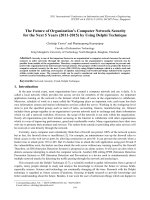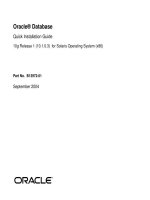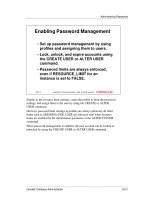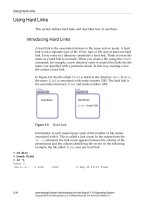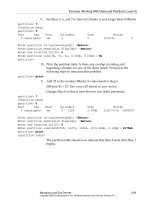Network Administration for the Solaris 9 Operating Environment SA-399 Student Guide phần 7 ppt
Bạn đang xem bản rút gọn của tài liệu. Xem và tải ngay bản đầy đủ của tài liệu tại đây (386.2 KB, 60 trang )
Introducing DNS Basics
Configuring DNS 10-13
Copyright 2002 Sun Microsystems, Inc. All Rights Reserved. Enterprise Services, Revision A
● PTR resource record type:
1.1.168.192 IN PTR sys11.one.edu.
● CNAME resource record type:
www.one.edu. IN CNAME sys11.one.edu.
The $TTL directive identifies the cache TTL value that remote DNS servers
receive when they query the information specified by this directive. This
directive, or control statement, was not available for use until BIND 8.2.x
versions.
Configuring the DNS Server
10-14 Network Administration for the Solaris™ 9 Operating Environment
Copyright 2002 Sun Microsystems, Inc. All Rights Reserved. Enterprise Services, Revision A
Configuring the DNS Server
The DNS name server is called the in.named process. The in.named
process is started at boot time only if the /etc/named.conf file exists.
Gathering Information
When you configure a DNS server, supply the server with the following
types of information:
● The names and addresses of root servers.
● The information required to resolve all domains for which the server
is authoritative. This information consists of name-to-address
translations.
● The information needed to resolve all reverse domains for which the
server is authoritative. This information consists of address-to-name
translations.
● The names and addresses of servers for all domains that are one
level below the domains being served by this server. This
information is sometimes referred to as parenting or delegating.
Editing the BIND Configuration File
BIND version 8.x.x and later versions use a new configuration file,
/etc/named.conf, that replaced the /etc/named.boot file. A BIND
version 4.9.x named.boot file can be converted to a named.conf file by
running the /usr/sbin/named-bootconf script.
The /etc/named.conf file contains statements that:
● Indicate the location of the file that includes the root servers
● Establish the server as a primary, a secondary, or a cache-only server
● Specify the server’s zones of authority
● Indicate the location of the server’s data files
● Selectively apply security for specific zones
● Define logging specifications
● Selectively apply options for a set of zones
Configuring the DNS Server
Configuring DNS 10-15
Copyright 2002 Sun Microsystems, Inc. All Rights Reserved. Enterprise Services, Revision A
The in.named process reads the /etc/named.conf file when the process
is started by the server’s startup script, /etc/rc2.d/S72inetsvc. The
configuration file directs the in.named process either to other servers or to
local data files for a specified domain.
The /etc/named.conf file contains statements and can contain
comments. Statements end with a semicolon (;), they can contain a block
of statements enclosed within curly braces ({}), and each statement in the
block is terminated with a semicolon (;). Comments can start with /* and
end with */, can follow either # or //, and can extend to the end of the
line.
Table 10-4 shows /etc/named.conf statements and their definitions.
Table 10-4 Statement Definitions for the /etc/named.conf File
Statement Definition
acl Defines a named IP address match list used for access
control. The address match list designates one or more
IP addresses or IP prefixes. The named IP address
match list must be defined by an acl statement before
it can be used elsewhere. No forward references are
allowed.
options Controls global server configuration options, and sets
default values for other statements.
zone Defines a zone. It selectively applies options on a
per-zone basis, rather than to all zones.
Configuring the DNS Server
10-16 Network Administration for the Solaris™ 9 Operating Environment
Copyright 2002 Sun Microsystems, Inc. All Rights Reserved. Enterprise Services, Revision A
Figure 10-3 shows the contents of the /etc/named.conf file.
Figure 10-3 The /etc/named.conf File
Configuring the DNS Server
Configuring DNS 10-17
Copyright 2002 Sun Microsystems, Inc. All Rights Reserved. Enterprise Services, Revision A
Editing the named.root File
The /var/named/named.root file specifies name-to-address mappings
for the root servers.
The information in this file is described as “hints” to the in.named
process because the name daemon attempts to contact one of the root
servers listed until one of the servers responds. The responding root
server returns a list of root servers. The name daemon uses this list that is
returned from the root server and does not use the servers that are
specified in the hints file again until the TTL value expires on the cached
root-server information.
Accordingly, it is not imperative that this file be precisely up-to-date, but
it should be checked every few months because root servers change from
time to time.
The following is a modified (the IN entries for servers D through L are not
present in the file retrieved from internic.net) excerpt taken from a
named.root file available at the
Web site.
; formerly NS.INTERNIC.NET
;
. 3600000 IN NS A.ROOT-SERVERS.NET.
A.ROOT-SERVERS.NET. 3600000 A 198.41.0.4
;
; formerly NS1.ISI.EDU
;
. 3600000 IN NS B.ROOT-SERVERS.NET.
B.ROOT-SERVERS.NET. 3600000 A 128.9.0.107
;
; formerly C.PSI.NET
;
. 3600000 IN NS C.ROOT-SERVERS.NET.
C.ROOT-SERVERS.NET. 3600000 A 192.33.4.12
< Part of file truncated>
; housed in Japan, operated by WIDE
;
. 3600000 IN NS M.ROOT-SERVERS.NET.
M.ROOT-SERVERS.NET. 3600000 A 202.12.27.33
; End of File
Configuring the DNS Server
10-18 Network Administration for the Solaris™ 9 Operating Environment
Copyright 2002 Sun Microsystems, Inc. All Rights Reserved. Enterprise Services, Revision A
where in the first record:
● The dot (.) in the first field denotes the root domain.
● The TTL field is 3600000 seconds. This field is historic and is not
used in this file.
● The IN class stands for Internet.
● The NS record type indicates that a name server is being defined for
the root domain.
● The fifth field of the first record (the data field) is the FQDN of a
root server. Note the trailing dot associated with this field.
and where in the second record:
● The first (domain) field contains the FQDN of the root server that is
defined in the previous record.
● The TTL field is 3600000 seconds. This field is historic and is not
used in this file.
● The record type, A, contains an IP address.
● For A records, the fourth data field contains the IP address of the root
server that is specified in the first field.
The NS and A records combine to define the name and address of a single
root server. This file specifies additional pairs of records, as appropriate.
Configuring the DNS Server
Configuring DNS 10-19
Copyright 2002 Sun Microsystems, Inc. All Rights Reserved. Enterprise Services, Revision A
Editing the Forward-Domain File
The forward-domain file contains the mappings of host names to IP
addresses for all systems in the domain that are being served by this name
server. In addition, this file must specify an SOA record and NS records for
all name servers for this domain. See Figure 10-3 on page 10-16 for more
information on this example.
; Information for the "forward" domain one.edu.
; Time to live 8 hours
$TTL 8h
@ IN SOA sys11.one.edu. root.sys11.one.edu. (
20011225; Version number
43200; Refresh timer - 12 hours
3600; Retry timer - 1 hour
604800; Expire timer - 1 week
3600; Negative caching info. kept 1hr
)
; Define name servers for this domain.
IN NS sys11.one.edu. ; primary
IN NS sys13.one.edu. ; secondary
; Define name to address mappings for this domain.
sys11 IN A 192.168.1.1
sys12 IN A 192.168.1.2
sys13 IN A 192.168.1.3
; CNAME aliases.
www IN CNAME sys11
; Loopback domain definition.
localhost IN A 127.0.0.1
The $TTL directive sets the default time to live for the zone’s information
to eight hours.
The SOA record is mandatory and has the following items:
● An at sign (@) in the domain field – This is a shortcut for the domain
that is being served (one.edu. in this case). The actual value for the
@ comes from the second field of the appropriate record in the
named.conf file. The @ also defines the default origin that
determines the domain appended to any partially qualified domain
name in the configuration file’s resource records.
● Data field argument 1 (sys11.one.edu.)– This is the name of the
primary master server for this domain in FQDN format.
Configuring the DNS Server
10-20 Network Administration for the Solaris™ 9 Operating Environment
Copyright 2002 Sun Microsystems, Inc. All Rights Reserved. Enterprise Services, Revision A
● Data field argument 2 (root.sys11.one.edu)– This is an email
address, in the format of
DNS_admin_name.domain_name
, that you
can use to report problems with the domain. The administrator is
usually the root user, as shown in this example. Note that the @ is
replaced with a dot in the SOA record because the @ has special
meaning in this file.
● Data field argument 3 – This is the version (serial) number that the
secondary slave servers use to determine if they need to perform a
zone transfer to get a fresh copy of zone data. Any time you make
changes to this file, remember to update this number in such a way
that it gets larger. It is always safe to start at 1 and add 1 with each
change, or to use today’s date.
● Data field argument 4 – The refresh timer is the time interval, in
seconds, after which the secondary master servers should check to
determine if the serial number has changed, and, if it has, a zone
transfer needs to occur.
● Data field argument 5 – The retry timer is the time interval, in
seconds, after which the secondary master servers check back if a
normal refresh failed. This timer is usually set to a smaller value than
the refresh timer.
● Data field argument 6 – The expire timer is the time interval in
seconds after which, if a secondary server cannot contact the primary
server or another secondary server, the entire zone data should be
discarded. This prevents the secondary servers that have lost contact
with the rest of the name servers from continuing to give out
potentially stale information.
● Data field argument 7 – The negative caching timer is the default
value of time that the server keeps negative responses from other
authoritative servers.
You should define an NS record for all name servers in this domain that
you want to be recognized by DNS servers.
Most of the remaining resource records are address records for each
system in the domain. Most of the host names are not fully qualified. The
names that are not fully qualified have the domain name origin (the value
of the @ in the SOA record by default) appended to them. This shorthand
method can save typing and improve the readability and maintainability
of the file.
The CNAME record defines host aliases or nicknames for hosts. The CNAME
record in this instance is similar to an entry of 192.168.1.1 sys11 www
in the /etc/inet/hosts file.
The localhost entry specifies the loopback address for all hosts.
Configuring the DNS Server
Configuring DNS 10-21
Copyright 2002 Sun Microsystems, Inc. All Rights Reserved. Enterprise Services, Revision A
Editing the Reverse-Domain File
Reverse-domain files, for example, /var/named/one.rzone, contain
mappings for address-to-name translation. Address-to-name translation is
important and is used by varying utilities, such as Network File System
(NFS), web servers, BIND, and sendmail.
The following is an example of a reverse-domain file:
; Information for the "reverse" domain 1.168.192.in-addr.arpa.
@ IN SOA sys11.one.edu. root.sys11.one.edu. (
20011226 ; Version number
43200 ; Refresh timer - 12 hours
3600 ; Retry timer - 1 hour
604800 ; Expire timer - 1 week
3600 ; Negative caching info. kept 1 hr.
)
; Define name servers for this domain.
IN NS sys11.one.edu.; primary
IN NS sys13.one.edu.; secondary
; Define address to name mappings for this domain.
1 IN PTR sys11.one.edu.
2 IN PTR sys12.one.edu.
3 IN PTR sys13.one.edu.
Observe the following about this file:
● The SOA record is as it was in the one.edu.zone file. The @ (at the
top of this resource record) in this example refers to the
1.168.192.in-addr.arpa. reverse domain.
● The address-to-name mappings are defined with the PTR record type.
The domain field in the PTR record contains the host portion of the IP
address. Because these resource records do not end with a . (dot), the
value of the @ is appended to each record. The argument field of the
PTR record should contain the FQDN of the name of the system that
is being pointed at. This completes the reverse address-to-name
mapping.
Configuring the DNS Server
10-22 Network Administration for the Solaris™ 9 Operating Environment
Copyright 2002 Sun Microsystems, Inc. All Rights Reserved. Enterprise Services, Revision A
Editing the Reverse-Loopback Domain File
Reverse-loopback domain files specify the reverse-loopback domain
address-to-name translation. The contents are hard-coded with the
exception that the server name changes depending on which server the
file is installed. This file is required on all DNS servers. Every name server
is the master for its own loopback address.
The /var/named/loopback_domain_info file is an example of a
reverse-loopback domain file:
; Information for the loopback domain 127.in-addr.arpa.
@ IN SOA sys11.one.edu. root.sys11.one.edu. (
20011226 ; Serial number
43200 ; Refresh timer - 12 hours
3600 ; Retry timer - 1 hour
604800 ; Expire timer - 1 week
3600 ; Negative caching info kept 1 hr.
)
; Define name servers for this domain.
IN NS sys11.one.edu.
; Define appropriate mappings for this domain.
1.0.0 IN PTR localhost.one.edu.
Observe the following about this file:
● You can use the @ when the domain name is the same as the origin,
127.in-addr.arpa. in this example.
● The only items you change from domain-to-domain in the SOA
record are the host name (first) argument and the email address used
to report problems.
● You must specify the name of the system being configured on the NS
line.
● Use all other lines as shown in this example.
Configuring the DNS Server
Configuring DNS 10-23
Copyright 2002 Sun Microsystems, Inc. All Rights Reserved. Enterprise Services, Revision A
Configuring Dynamic Updates
Dynamic updates cause a DNS server to automatically be updated with
DHCP host information from a DHCP server. This allows nomadic DHCP
users to have access to systems and services without manual
administration. To configure a server to allow dynamic updates to occur,
complete the following steps:
1. Log in as root on the DNS primary server, edit the
/etc/named.conf file, and add allow-update statements to both
the forward and reverse zones. For example:
zone "one.edu" in {
type master;
file "one.zone";
allow-update { 127.0.0.1; 192.168.1.1; };
};
zone "1.168.192.in-addr.arpa" in {
type master;
file "one.rzone";
allow-update { 127.0.0.1; 192.168.1.1; };
};
2. Restart the in.named process.
sys11# pkill -HUP in.named
Configuring Security
Because of the nature of the Internet, DNS can be vulnerable to
unauthorized access.
Beginning with BIND version 8.x.x, security features are implemented
through the /etc/named.conf configuration file. Two important security
considerations are the control of name queries and the control of zone
transfers. By default, servers respond to any query or request for a zone
transfer. You can modify this behavior by using the allow-query and
allow-transfer keywords.
The allow-query statement enables you to establish an IP address-based
access list for queries. You can apply this access list to a specific zone or to
all queries that are received by the server. The IP address list determines
which systems receive responses from the server.
Configuring the DNS Server
10-24 Network Administration for the Solaris™ 9 Operating Environment
Copyright 2002 Sun Microsystems, Inc. All Rights Reserved. Enterprise Services, Revision A
You can restrict queries to all zones by using the allow-query keyword
as an argument to the options statement for the zone.
For example:
options {
allow-query { 192.168.1/24; 192.168.3/24; };
};
In this case, only systems with the IP addresses 192.168.1.
xxx
and
192.168.3.
xxx
receive responses from the name server.
You can restrict queries for a specific zone by using the allow-query
keyword as an argument to the zone statement. For example:
zone "one.edu" in {
type master;
file "one.zone";
allow-query { 192.168.3/24; };
};
In this case, only subnet 192.168.3.0 has access to the resource records
for this zone.
In the same manner, the allow-transfer keyword can limit which
systems may receive a zone transfer from a name server. You can restrict
zone transfers from a name server by using allow-transfer in the
options statement. For example:
options {
allow-transfer {192.168.1.3;};
};
The allow-transfer keyword can also be applied to a specific zone, if
you want. Another feature that often is associated with restricting queries
and transfers is access control lists (ACLs). The list of IP addresses used in
the previous examples could be replaced by an ACL.
You can configure ACLs by using the acl keyword to build an ACL list
that can be used as an argument to the allow-query and
allow-transfer keywords.
Configuring the DNS Server
Configuring DNS 10-25
Copyright 2002 Sun Microsystems, Inc. All Rights Reserved. Enterprise Services, Revision A
For example:
acl "local" { 192.168.1.0/24; 192.168.2.0/24; 192.168.3.0/24;};
zone "one.edu" in {
type master;
allow-query { "local"; };
allow-transfer { "local"; };
};
Configuring Secondary DNS Servers
The contents of the /etc/named.conf file on the secondary DNS server
can be less complex than that of the primary server. If a server is to act as
both a primary server for some domains and a secondary server for other
domains, the /etc/named.conf file must contain keywords that are
appropriate to both servers. The master keyword denotes a primary
server for a domain, and the slave keyword denotes a secondary server
for a domain when used as arguments to the type directive.
An example of a /etc/named.conf file for a secondary master server is:
options {
DIRECTORY "/var/named";
};
zone "." in {
type hint;
file "named.root";
};
zone "127.in-addr.arpa" in {
type master;
file "loopback-domain-info";
};
zone "one.edu" in {
type slave;
file "one-backup";
masters {
192.168.1.1;
};
};
zone "1.168.192.in-addr.arpa" in {
type slave;
file "one-rbackup";
masters {
192.168.1.1;
};
};
Configuring the DNS Server
10-26 Network Administration for the Solaris™ 9 Operating Environment
Copyright 2002 Sun Microsystems, Inc. All Rights Reserved. Enterprise Services, Revision A
Observe the following about this file:
● Secondary servers are configured with and use the same root server
hints file as the primary name server.
● Secondary servers are configured with and use the same
loopback-domain-info file syntax as the primary name server,
except that the secondary name server is always listed as the
primary for the loopback address.
● The one-backup and one-rbackup files and their contents are
automatically created by the secondary server’s in.named process
after the primary name server is successfully contacted.
● The IP address that the secondary server should use to download its
zone files from is listed following the masters keyword. Up to 10 IP
addresses can be listed.
Secondary servers will start the in.named process during the boot process
if the /etc/named.conf file exists. The script /etc/rc2.d/S72/inetsvc
script reads the file and starts the process.
Note – Secondary servers can also perform zone transfers from other
secondary servers.
Configuring DNS Clients
All DNS clients require the nsswitch.conf and resolv.conf files. DNS
servers also function as DNS clients.
The /etc/nsswitch.conf file specifies to the resolver library routines
that DNS uses when resolving host names and addresses. Modify the
nsswitch.conf file by editing the hosts line and adding the dns
keyword. To ensure proper network interface configuration during the
boot process, make sure that the files keyword is listed first. The
following example shows a hosts entry configured for DNS:
hosts: files dns
Configuring the DNS Server
Configuring DNS 10-27
Copyright 2002 Sun Microsystems, Inc. All Rights Reserved. Enterprise Services, Revision A
The /etc/resolv.conf file specifies the name servers that the client must
use, the client’s domain name, and the search path to use for queries.
;resolv.conf file for DNS clients of the one.edu. domain.
search one.edu two.edu three.edu
nameserver 192.168.1.1 ; Primary Master Server for one
nameserver 192.168.1.2 ; Secondary Master Server for one
Observe that the search keyword specifies domain names to append to
queries that were not specified in the FQDN format. The first domain
listed following the search keyword designates the client’s domain.
The nameserver keyword specifies the IP address of the DNS servers to
query. Do not specify host names. You can use up to three nameserver
keywords to increase your chances of finding a responsive server. In
general, list the name servers that are nearer to the local network first. The
client attempts to use the loopback address if there is no nameserver
keyword or if the /etc/resolv.conf file does not exists.
Troubleshooting the DNS Server Using Basic Utilities
10-28 Network Administration for the Solaris™ 9 Operating Environment
Copyright 2002 Sun Microsystems, Inc. All Rights Reserved. Enterprise Services, Revision A
Troubleshooting the DNS Server Using Basic Utilities
Usually, you cannot test every record in your domain files. Test
representative samples, and test several servers in other domains to
ensure that you have correctly identified the root servers.
Examining the/var/adm/messages File
The in.named process sends messages to the syslog process, which
processes messages at various syslog levels and sends messages to the
/var/adm/messages file by default. The contents of this file often show
where configuration errors were made. For example, the following entry
shows that the negative caching timer was not properly set, indicating
that pre-BIND version 8.2 is not properly converted.
Dec 26 02:28:06 sys11 named[1404]: [ID 295310 daemon.notice] starting
(/etc/named.conf). in.named BIND 8.2.4 Tue Nov 13 17:10:11 PST 2001
Dec 26 02:28:06 sys11 s81_51-5.9-May 2002
Dec 26 02:28:06 sys11 named[1404]: [ID 295310 daemon.warning] Zone
"one.edu" (file one.zone): No default TTL ($TTL <value>) set, using SOA
minimum instead
The following message informs you might want to edit the SOA record to
be more than seven days:
Dec 26 02:28:06 sys11 named[1404]: [ID 295310 daemon.warning] one.zone:
WARNING SOA expire value is less than 7 days (432000)
Syntax errors are pointed out in the following example:
Dec 26 10:38:15 instructor named[564]: [ID 295310 daemon.notice]
starting. in.named BIND 8.2.2-P5 Tue Jun 19 14:55:52 PDT 2001
Dec 26 10:38:15 instructor Beta-5.9-May 2002
Dec 26 10:38:15 instructor named[564]: [ID 295310 daemon.notice]
root.zone:18: Database error near (instructor.thirty.edu.)
Dec 26 10:38:15 instructor named[564]: [ID 295310 daemon.notice]
root.zone:20: Database error near (one.edu.)
Dec 26 10:38:15 instructor named[564]: [ID 295310 daemon.notice]
root.zone:22: Database error near (three.edu.)
Dec 26 10:38:15 instructor named[564]: [ID 295310 daemon.notice]
root.zone:27: Database error near (sys31.three.edu.)
Dec 26 10:38:15 instructor named[564]: [ID 295310 daemon.warning] master
zone "" (IN) rejected due to errors (serial 20011226)
Dec 26 10:38:15 instructor named[565]: [ID 295310 daemon.notice] Ready to
answer queries.
Troubleshooting the DNS Server Using Basic Utilities
Configuring DNS 10-29
Copyright 2002 Sun Microsystems, Inc. All Rights Reserved. Enterprise Services, Revision A
Using the nslookup Utility
Before the Solaris OE, the primary test tool bundled with BIND was the
nslookup utility. As of the Solaris 9 OE, the dig utility is also bundled
with the Solaris 9 OE. The nslookup utility usually does the following:
● Sends queries and displays replies for any of the valid resource
record types
● Queries the DNS server of your choice
● Debugs almost any domain that is not protected by a firewall
A typical debug session might look like the following:
Note – Some output is omitted for clarity.
sys12# nslookup
Default Server: sys11.one.edu
Address: 192.168.1.1
>
The server listed as the default server is usually the first server listed in
the /etc/resolv.conf file. You can change this server later by using the
nslookup server directive.
The nslookup utility uses a > (greater than) prompt. The name of the
server that is being queried is always displayed first (and is omitted from
future examples), followed by the query and the reply.
To list the contents of the domain, use the following command:
> ls one.edu
[sys11.one.edu]
$ORIGIN one.edu.
sys12 8H IN A 192.168.1.2
sys13 8H IN A 192.168.1.3
sys11 8H IN A 192.168.1.1
>
Use of $ORIGIN variable resets the current origin, setting it to the value @,
included in the beginning SOA record (shorthand notation).
Troubleshooting the DNS Server Using Basic Utilities
10-30 Network Administration for the Solaris™ 9 Operating Environment
Copyright 2002 Sun Microsystems, Inc. All Rights Reserved. Enterprise Services, Revision A
In the preceding example, the name servers and address records that
make up the one.edu domain are listed.
> set q=ns
> one.edu.
one.edu nameserver = sys11.one.edu
sys11.one.edu internet address = 192.168.1.1
>
The set q=ns subcommand lists the name server and its location
(IP address) for the specified domain (one.edu.)
In this next example, all of the name servers for the domain are listed and
the reverse-address lookup is tested. Notice that the nslookup utility
allows you to enter the IP address in regular forward notation without the
trailing in-addr.arpa. domain name.
> set q=ptr
> 192.168.1.1
1.1.168.192.in-addr.arpa name = sys11.one.edu
1.168.192.in-addr.arpa nameserver = sys11.one.edu
sys11.one.edu internet address = 192.168.1.1
>
In this example, the DNS server is changed from the sys11.one.edu.
server to the sys13.one.edu. server.
> server sys13.one.edu.
Default Server: sys13.one.edu
Address: 192.168.1.3
>
To make sure that DNS is working correctly, complete the following:
● Test several name-to-address translations within your domain.
● Test several address-to-name translations within your domain.
● Test name-to-address and address-to-name translations in other
domains.
● List name servers for your own domain and a few remote domains.
● List SOA records for your own domain and a few remote domains.
● Test the 127.0.0.1 loopback address for resolution.
Troubleshooting the DNS Server Using Basic Utilities
Configuring DNS 10-31
Copyright 2002 Sun Microsystems, Inc. All Rights Reserved. Enterprise Services, Revision A
If any of your tests have errors or have no response, you must debug the
problem that is often an omission from a file, such as a missing
IP address or host name entry or a typographic error in a host entry.
Dumping a Snapshot of the DNS Database
The INT signal, when used with the pkill utility, causes the name
daemon to take a snapshot of its in-memory cached data and write this
information to the /var/named/named_dump.db file in ASCII (resource
record) format. If you prefer to use the kill utility, the /etc/named.pid
file contains the process identification number (PID) of the in.named
process that is currently running.
You can use the INT signal with the pkill utility to debug both
authoritative and non-authoritative lookups. For example:
sys11# pkill -INT in.named
You can view the resulting file with your text editor and examine it for
problems. For example, a missing trailing dot at the end of an FQDN
results in the name being stored internally with the domain part of the
name being repeated, that is one.edu.one.edu.
Changing the Debug Level of the Name Daemon
You can use the USR1 signal with the pkill utility to cause the name
daemon (in.named) to increase its debug level (disabled by default) by
one. For example:
sys11# pkill -USR1 in.named
Each successive increase generates more debug output. You can examine
the resulting output in the /var/named/named.run file. A discussion of
this file is beyond the scope of this course and is described in NS and
BIND (4th Edition), by Paul Albitz and Cricket Liu, O’Reilly & Associates,
April 2001.
You can use the USR2 signal with the pkill utility to cause the name
daemon to return to debug level 0 in which debugging is turned off.
Troubleshooting the DNS Server Using Basic Utilities
10-32 Network Administration for the Solaris™ 9 Operating Environment
Copyright 2002 Sun Microsystems, Inc. All Rights Reserved. Enterprise Services, Revision A
Forcing the in.named Process to Reread Configuration
Files
You can use the HUP signal with the pkill utility to cause the name
daemon to reread all of its configuration files. For example:
sys11# pkill -HUP in.named
An advantage of using the HUP signal as opposed to restarting the
in.named process is that the zone files are reread, but all of the previously
cached information is retained.
Modifying the DNS Server With the ndc Utility
Administrators use the name daemon control program (ndc) to control the
operation of a name server. Name servers have always been controlled by
administrators sending signals, such as SIGHUP and SIGINT. The ndc
utility provides a finer granularity of control, and it can be used both
interactively and non-interactively. For example:
1. Start the ndc utility in the interactive mode.
sys11# ndc
Type help -or- /h if you need help.
2. Display usage help.
ndc> /h
/h(elp) this text
/e(xit) leave this program
/t(race) toggle tracing (protocol and system events)
/d(ebug) toggle debugging (internal program events)
/q(uiet) toggle quietude (prompts and results)
/s(ilent) toggle silence (suppresses nonfatal errors)
3. Display more usage information.
ndc> help
(builtin) start - start the server
(builtin) restart - stop server if any, start a new one
getpid
status
stop
exec
reload [zone]
reconfig [-noexpired] (just sees new/gone zones)
dumpdb
stats [clear]
Troubleshooting the DNS Server Using Basic Utilities
Configuring DNS 10-33
Copyright 2002 Sun Microsystems, Inc. All Rights Reserved. Enterprise Services, Revision A
trace [level]
notrace
querylog
qrylog
help
quit
4. Restart the in.named process.
ndc> restart
new pid is 1754
5. Display the status information, including the BIND version.
ndc> status
in.named BIND 8.2.4 Tue Nov 13 17:10:11 PST 2001 s81_51-5.9-May 2002
config (/etc/named.conf) last loaded at age: Tue Dec 25 22:14:06 2001
number of zones allocated: 64
debug level: 0
xfers running: 0
xfers deferred: 0
soa queries in progress: 0
query logging is ON
server is up and running
6. Dump the database by using the following command:
ndc> dumpdb
Database dump initiated.
You can also use the pkill -INT in.named command.
7. Exit the utility.
ndc> /e
sys11#
You can also use the ndc utility from the command line. For example, to
dump the database to the /var/named/named_dump.db file, perform the
command:
sys11# ndc dumpdb
Database dump initiated.
sys11#
Exercise: Configuring DNS
10-34 Network Administration for the Solaris™ 9 Operating Environment
Copyright 2002 Sun Microsystems, Inc. All Rights Reserved. Enterprise Services, Revision A
Exercise: Configuring DNS
In this exercise, you configure DNS.
Preparation
Refer to the lecture notes as necessary to perform the tasks listed.
Before starting this lab; make sure that:
● The classroom network is not connected to the public Internet
because the names and addresses used are not registered with the
ICANN.
● The instructor has set up a root domain server for use in this lab.
● The domains to be set up are called one.edu., two.edu., and
three.edu., respectively.
The self-contained root server (instructor) serves the .(root), edu.,
30.168.192.in-addr.arpa., and 127.in-addr.arpa.loopback
domains.
Task Summary
In this exercise, team up with the other students on your subnet, and
configure a DNS server and clients on your subnet. You practice using
troubleshooting tools, such as the nslookup utility. Work as a team, and
move as a team to each system that is to be configured. This way you
experience most of the aspects of configuring DNS.
Exercise: Configuring DNS
Configuring DNS 10-35
Copyright 2002 Sun Microsystems, Inc. All Rights Reserved. Enterprise Services, Revision A
Tasks
To configure DNS, complete the following steps:
Your first task is to configure your domain’s primary DNS server.
Working on the Primary DNS Server
1. Set up the /etc/named.conf file for your domain on the system that
will be your domain’s primary DNS server. You can create the file
yourself, or you can use the template file that your instructor makes
available to you.
a. What is the purpose of the /etc/named.conf file?
_____________________________________________
_____________________________________________
_____________________________________________
_____________________________________________
b. What is purpose of the following /etc/named.conf file
keywords?
● zone
_________________________________________
_________________________________________
● options
_________________________________________
_________________________________________
2. Create the /var/named directory.
Write the command that you use:
_____________________________________________________________
Exercise: Configuring DNS
10-36 Network Administration for the Solaris™ 9 Operating Environment
Copyright 2002 Sun Microsystems, Inc. All Rights Reserved. Enterprise Services, Revision A
3. Set up the /var/named/named.root file for your domain on the
system that will be your domain’s primary DNS server. You can
create the file yourself, or you can use the template file that your
instructor makes available to you.
a. What is the purpose of the named.root file?
________________________________________________________
________________________________________________________
________________________________________________________
________________________________________________________
b. Where can you obtain a current copy of the named.root file?
________________________________________________________
________________________________________________________
________________________________________________________
________________________________________________________
c. What is the purpose of the following resource record types?
● NS
____________________________________________________
● A
____________________________________________________
4. Set up the zone file for your domain on the system that will be your
domain’s primary DNS server. You can create the file yourself, or
you can use the template file that your instructor makes available to
you.
a. What is the purpose of a domain’s zone file?
________________________________________________________
________________________________________________________
________________________________________________________
b. What is the purpose of the SOA resource record?
________________________________________________________
________________________________________________________
c. What is the purpose of the CNAME resource record?
________________________________________________________
________________________________________________________
Exercise: Configuring DNS
Configuring DNS 10-37
Copyright 2002 Sun Microsystems, Inc. All Rights Reserved. Enterprise Services, Revision A
5. Set up the reverse-lookup file for your domain on the system that
will be your domain’s primary DNS server. You can create the file
yourself, or you can use the template file that your instructor makes
available to you.
a. What is the purpose of the reverse-lookup zone file?
________________________________________________________
b. What is the purpose of the PTR resource record?
________________________________________________________
6. Set up the loopback file for your domain on the system that will be
your domain’s primary DNS server. You can create the file yourself,
or you can use the template file that your instructor makes available
to you.
Your second task is to configure name resolution on all of your systems.
Working on All Systems
7. Working on all of your DNS clients and DNS servers, copy the
/etc/nsswitch.dns file to the /etc/nsswitch.conf file.
Write the commands that you use:
________________________________________________________
________________________________________________________
________________________________________________________
a. What is the purpose of the /etc/nsswitch.conf file?
________________________________________________________
________________________________________________________
b. What effect does the dns keyword have on this file?
________________________________________________________
________________________________________________________
________________________________________________________
